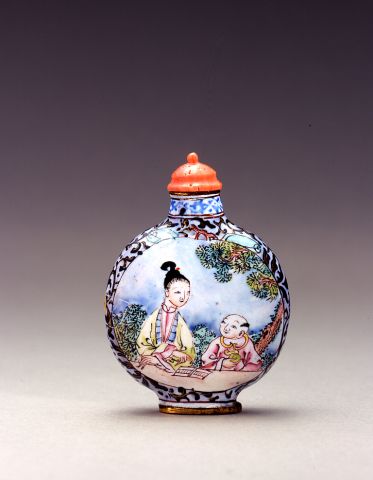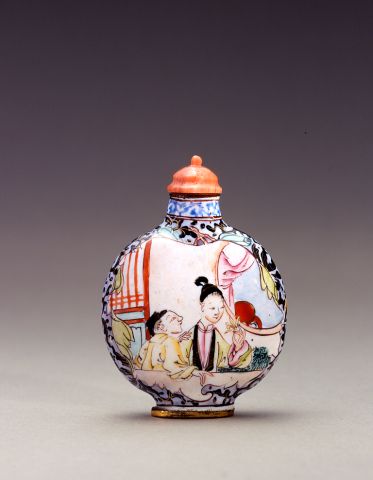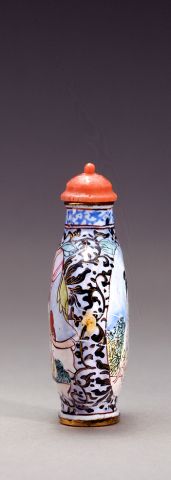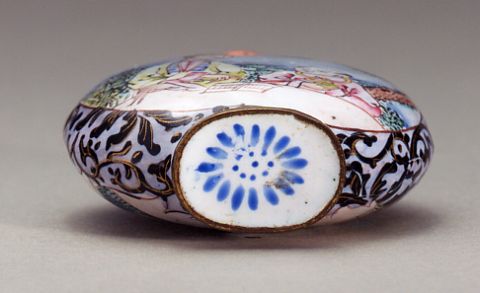



Bottle ID: 00490
GUANGZHOU, FAMILLE ROSE, WOMAN & CHILDREN IN LANDSCAPE
Date: 1720-1760
Height: 47 mm
Enamels on copper, of flattened rounded form with rounded shoulders tapering to a straight mouth and the bottom tapering towards a slightly splayed base, decorated in famille rose enamels within a vignette on each side, with on one side, a woman seated at a desk under a pine tree in a garden, a small boy sitting beside her; the reverse with a woman holding a lotus flower and her servant seated outside a pavilion on a terrace, the vignettes surrounded by a scrolling foliate design, the neck with a blue enamel patterned border, the white base with a blue enamel flower-head.
Probably Imperial, attributed to the Guangzhou Workshops, Guangzhou.
Similar Examples:
Moss, Hugh M. [ed.] Chinese Snuff Bottles: 6, from the Collection of the Rt. Hon. The Marquess of Exeter, K.C.M.-G., 1974, p. 108, E. 20.
Provenance:
Hugh Moss [HK] Ltd.
Exhibited:
Annual Convention ICSBS Toronto, October 2007
During the seventeenth century, the Kangxi Emperor in Beijing received tributes from his counterparts around the world, as well as from European royalty. This included Louis XIV who had sent the Emperor numerous enamel on porcelain paintings and other objects when he learned of Kangxi's fascination for both enameling and Western subjects. In 1697, a year after the start of the Palace Workshops, the Jesuit Bouvet was sent back to France from the Beijing Court to find and recruit enamelers to return with him. Bouvet was unsuccessful and even with the Jesuits Castiglione and Ripa, established at Court, somewhat unenthuisiastically, trying their hand at enameling, Western-style enameling did not reach the heights it subsequently did under Qianlong.
It became a tradition for enamel artists to be sent from Guangzhou (Canton) to the Court in Beijing from the reign of Kangxi onwards. In 1716, two enamelers - Pan Chun and Yang Shizhang were sent to the Court to work in the enamel workshops. In 1719, the French enameler Jean-Baptiste Gravereau (also known as Chen Zhongxin) was summoned to pass on Western enameling techniques to the Court artisans.
During the Qianlong period, enameling in Guangzhou (Canton) became more and more popular as an art form, with Western subjects and the use of European painting technique being in vogue. It is documented that the Qianlong Emperor ordered six Canton enamelers to produce an enamel on copper bottle as a test before they were accepted into the Palace Workshops. It is not recorded if all six were admitted!
One of the results of the test was the transfer of style between Guangzhou and Beijing out of the Palace and into the commercial mainstream. The manufacture of enamel on metal bottles in Guangzhou, specifically for the Palace, appears to have strengthened the influence that Beijing had on the Guangzhou enamelers.
< Back to full list

 English
English 中文
中文